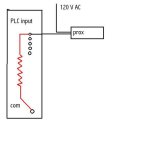I am trying to interface a 2 wire turck prox into a schneider smart relay. I have a schneider SR2A201FU and a turck BI2G12AZ33XB3131.
When I connect the prox correctly to the input, the input stays on all the time. The prox does function properly, as I have connected it to a relay and it switches as it should. I have used the search and found other people with similar issues. The replies have been basically to connect a resistor in parallel with the input load and it should take care of the problem. This apparently reduces the voltage at off state.
I have tried this with both a 100K and a 220K 2W resistors. Neither configuration gave any change.My controller is guaranteed off below 40 VAC and on above 79 VAC. I have other specs if they are needed. Can someone help me spec a resistor that will help, or tell me what I am doing wrong? Thank you in advance.
Dustin
When I connect the prox correctly to the input, the input stays on all the time. The prox does function properly, as I have connected it to a relay and it switches as it should. I have used the search and found other people with similar issues. The replies have been basically to connect a resistor in parallel with the input load and it should take care of the problem. This apparently reduces the voltage at off state.
I have tried this with both a 100K and a 220K 2W resistors. Neither configuration gave any change.My controller is guaranteed off below 40 VAC and on above 79 VAC. I have other specs if they are needed. Can someone help me spec a resistor that will help, or tell me what I am doing wrong? Thank you in advance.
Dustin



